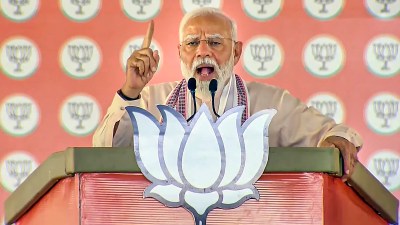- India
- International
How inflation bonds were hit by inflation targeting measures
Product development in the Indian debt markets has been more of a challenge for policy makers. It is not just inflation bonds but retailing of sovereign bonds or treasury bills which the government and the central bank has found it to be a huge challenge.
 For the sovereign, lowering the cost of borrowings is important. (Illustration :C R Sasikumar)
For the sovereign, lowering the cost of borrowings is important. (Illustration :C R Sasikumar)
In mid 2013, when the government was battling a twin deficit problem — on the current account marked by huge gold imports and a widening fiscal deficit — the finance ministry and the Reserve Bank of India (RBI) decided to launch inflation indexed bonds.
These bonds are popular in many other countries and the government hoped it would encourage people to invest in a product which would provide them greater protection when inflation was high, rather than locking money in gold — seen as an idle asset.
At that time, the government had said that these bonds would help protect the savings of the poor and the middle class from inflation and incentivise the household sector to save in financial instruments rather than buy gold. That was the year when India was battling a huge surge in gold imports — putting pressure on the currency and on inflation.
Later that year, after Raghuram Rajan took over as RBI Governor, these inflation indexed bonds were launched by being linked to the Wholesale Price Index or WPI — with an annual return over this benchmark. Soon, the central bank followed this by launching the Inflation Indexed National Savings Certificates for retail investors linking it to Consumer Price Index or CPI. The returns offered to investors was a coupon rate of 1.5 per cent annually over the inflation rate. The launch of these products was done at a time when inflation was relatively high and well before the government and the RBI decided to sign an agreement which bound the central bank to contain inflation to a specific target of 4 per cent in the medium term.
Institutional investors — such as mutual funds, besides retail investors too bought into this — keeping in mind the country’s inflation trajectory in the period prior to 2014, when inflation was in double digits for a sustained period. And the RBI thought that the new series of these bonds were way better than the Capital Indexed Bonds or CIB’s which it had issued in 1997 considering that the protection offered to savers then was only on the principal and not to interest payments. So this time around, it offered a product designed to provide inflation protection on both principal and interest.

However, with inflation trending down over time, the issuer of these bonds, the government, has been up against unhappy investors, leading to a large chunk of these inflation linked bonds issued to institutional investors being bought back after a limited window was opened. The pricing of these bonds and the fact that there was no preferential tax treatment on these bonds put off many investors though the government was told to make it attractive by the central bank which manages its borrowings. And now with inflation under shooting the RBI’s inflation target, there is another set of investors, retail, who are sore at the kind of returns they are now stuck with, with little avenues of exit.
A large chunk of institutional investors — who had put in over Rs 6,000 crore — managed to exit by offering their bonds for repurchase. But retail investors who had collectively invested a little over Rs 90 crore are now looking for an exit option, having taken a wrong bet. If that does happen, it would signal a set back to another attempt by the government and India’s central bank to offer an investment product which is attractive to retail investors — rather than gold — not just in terms of returns but also liquidity and design and simplicity of the product.
In the past, earlier central bank chiefs were wary of inflation targeting. Governor Subbarao addressed this issue in his book when he said that in practical terms, if the RBI is enjoined to deliver an inflation rate, the government will have to acquiesce in the growth rate that results. So if the government imposes a growth target on top of the inflation target, inflation targeting will lose credibility. What he says is that growth and inflation are not independent variables, which is that a target cannot be set simultaneously for growth and inflation as if one is fixed the other is automatically determined. His predecessor, Y V Reddy, too had been sceptical about the feasibility of inflation targeting.
Product development in the Indian debt markets has been more of a challenge for policy makers. It is not just inflation bonds but retailing of sovereign bonds or treasury bills which the government and the central bank has found it to be a huge challenge. Institutional Investors, who bought inflation indexed bonds, are now pitching with the government to open a new window to repurchase these long-term bonds. So are retail investors who tested out a new product. For the sovereign, lowering the cost of borrowings is important. Whether it will prefer to mop up at least the retail portion to keep a small segment happy without having to break into a sweat remains to be seen.
Apr 25: Latest News
- 01
- 02
- 03
- 04
- 05








































